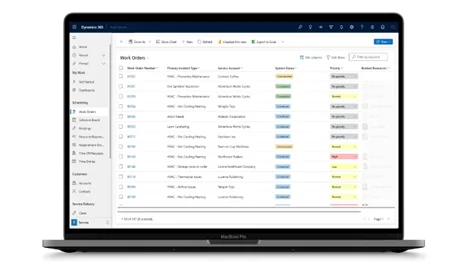Table of Contents
Introduction
As an AlphaBOLD consultant, one of the most common questions I hear from architecture, engineering, and construction (AEC) leaders when discussing business applications is: Why should we invest in Dynamics 365? It’s a valid concern—every firm wants to ensure its technology purchases drive real value. Over the years, I’ve shared countless insights on the reasons AEC leaders invest in Dynamics 365. While some factors vary based on a firm’s specific focus within the AEC industry, many core reasons remain the same.
This blog will explore the top 10 reasons AEC leaders invest in Dynamics 365, drawing from my experiences with firms lacking a robust business application and the tangible impact the solution had once implemented.
Reasons AEC Leaders Invest in Dynamics 365
1. End-to-End Project Visibility & Control:
Data silos can severely hinder project efficiency. For instance, as per Dataversity, knowledge workers spend 12 hours a week “chasing data,” which could be better utilized elsewhere.
AEC firms lose millions due to fragmented estimating, scheduling, procurement, finance, and field operations data. When these systems operate in silos, decision-makers struggle with misallocated resources, unexpected cost overruns, and preventable risks. In fact, this is one of the top reasons companies turn to Microsoft partners like AlphaBOLD.
What happens without real-time visibility?
Imagine you’re overseeing a $300M infrastructure project. One morning, you receive a report that steel procurement costs have risen by 20%. However, your finance team remains unaware because procurement data is stored in a separate system. Budget allocations have already been spent elsewhere when the issue is flagged, forcing your team into emergency cost-cutting mode—delaying progress and risking contract penalties. This lack of integration is one of the key reasons AEC leaders invest in Dynamics 365. Centralizing data ensures real-time visibility across all project phases, preventing costly surprises.
The Microsoft Dynamics Solution:
This robust platform integrates project workflows across finance, procurement, scheduling, and field teams, eliminating silos and providing a unified, real-time view of costs, resource allocation, and risks.
- AI-driven forecasting flags budget risks before they escalate.
- Automated alerts notify teams of cost variances and procurement delays.
- Seamless integration ensures design changes automatically update schedules and budgets.
- Cloud-based access keeps field and office teams aligned, reducing errors and rework.

2. Seamless Integration with AEC Tools (BIM, CAD, IoT, ERP, CRM):
Another key reason I’ve seen AEC leaders invest in Dynamics 365 is its ability to integrate seamlessly with specialized industry tools Most clients we work with have relied on multiple standalone applications—BIM for design, ERP for finance, CRM for client management, and IoT for equipment tracking. However, these systems rarely communicate, creating inefficiencies, misalignment, and costly errors.
What do these inefficiencies mean for an AEC firm?
Take, for example, a public sector infrastructure firm managing a $500M highway project. The engineering team makes design changes in BIM, but procurement doesn’t adjust in time because the financial and scheduling systems aren’t connected. As a result, material deliveries are delayed, causing construction setbacks and cost penalties.
The Microsoft Dynamics Solution:
This platform eliminates system fragmentation by creating a connected ecosystem where BIM, ERP, CAD, IoT, and CRM work together in real-time.
- BIM and CAD integration ensures design changes automatically update schedules, procurement, and financial projections.
- IoT-enabled equipment tracking provides real-time visibility into asset utilization and maintenance needs.
- ERP and project management synchronization prevents procurement delays and material shortages.
- AI-driven workflows align project managers, finance teams, and procurement to reduce errors and miscommunication.
With one integrated platform, AEC firms streamline operations, minimize costly delays, and improve team coordination—ensuring projects stay on track and within budget.
3. Better Cost Control & Financial Forecasting:
A common reason AEC leaders invest in Dynamics 365 is to gain better control over project costs. AEC projects often suffer from hidden costs, inaccurate budget forecasting, and cost overruns. According to TechTarget, incorrect or siloed data can cost a company up to 30% of its annual revenue. Traditional financial reporting tools are reactive, meaning firms only recognize budget issues after impacting profitability.
How do hidden costs affect AEC firms?
Consider a private construction firm building a new hospital. Midway through the project, they discover that labor costs are 15% over budget due to inefficient workforce allocation. Since financial reports are generated monthly, there’s no opportunity to adjust before profit margins take a significant hit.
The Microsoft Dynamics Solution:
This robust tool transforms cost management by providing real-time financial tracking, AI-driven forecasting, and automated cash flow management.
- Live financial dashboards give executives instant access to budget data, eliminating delays in cost reporting.
- AI-powered forecasting predicts labor and material cost trends based on historical data, helping firms proactively manage expenses.
- Integrated procurement and finance ensure project managers, accounting teams, and field supervisors stay aligned on cost allocations.
- Automated invoicing and contract management prevent errors, reduce disputes, and improve cash flow predictability.
Ready to See Dynamics 365 in Action?
With data-driven cost control and predictive insights, AEC firms using Dynamics 365 can identify financial risks early, prevent overruns, and protect profit margins—ensuring greater profitability and financial stability.
Get Expert Help4. Regulatory Compliance & Risk Management:
Regulatory compliance and risk management are among the top reasons AEC leaders invest in Dynamics 365. AEC firms operate in a highly regulated environment, requiring compliance with OSHA, ISO, LEED, and local government laws—a complex, time-consuming, and high-stakes process. Failing an audit can lead to project shutdowns, costly penalties, and reputational damage.
What happens when compliance isn’t managed effectively?
Consider a government-funded commercial project under audit. Safety documentation is scattered across multiple departments, making it impossible to provide accurate records quickly. As a result, the project fails inspection, delaying progress by six months and costing millions in penalties.
The Microsoft Dynamics Solution:
This powerful CRM streamlines compliance and risk management by centralizing regulatory requirements, automating safety protocols, and ensuring project documentation is always audit-ready.
- Unified compliance tracking consolidates regulatory documentation, safety reports, and inspection logs in one platform.
- Automated workflows ensure that required safety checks and regulatory approvals are timely.
- AI-driven risk assessments analyze project data to detect potential compliance violations before they occur.
- Role-based access control ensures the right teams access necessary compliance documentation, reducing administrative bottlenecks.
By digitizing compliance and automating risk management, AEC firms using Dynamics can reduce regulatory burdens, avoid costly delays, and minimize legal exposure—keeping projects on track and compliant.
5. Improved Collaboration Across Teams, Clients & Contractors:
Collaboration is a major reason why AEC leaders invest in Dynamics 365. Large AEC projects involve multiple stakeholders—architects, engineers, contractors, suppliers, and government agencies—working with different systems and workflows. Many of my clients struggle with miscommunication, version control issues, and data silos, which often result in delays, costly rework, and contract disputes.
What happens when teams aren’t working from the same information?
Let’s say a multinational real estate firm managing a large-scale commercial project with contractors across different time zones. A key milestone is delayed because updated blueprints were shared via email instead of a centralized collaboration platform. The contractor references an outdated version, leading to construction errors, expensive rework, and schedule overruns.
The Microsoft Dynamics Solution:
The powerful Microsoft CRM solution creates a connected collaboration ecosystem where teams, clients, and contractors work from a single source of truth with real-time updates and secure access controls.
- Microsoft Teams & SharePoint integration enables seamless document sharing and real-time project collaboration.
- Live project dashboards provide a centralized, up-to-date view of project progress, ensuring all teams work from the latest information.
- Version-controlled document management prevents outdated files from being referenced, reducing costly mistakes.
- Cloud-based access allows project stakeholders to review blueprints, approvals, and contracts from any location on any device.
By eliminating data silos and communication gaps, AEC firms enhance coordination, accelerate decision-making, and prevent costly project delays.
6. AI & Automation for Faster Decision-Making:
AEC firms manage complex project workflows, including manual approvals, change orders, and resource scheduling. Decision-making slows down when these tasks rely on email chains, paper-based approvals, or disconnected systems, leading to delays, cost overruns, and operational inefficiencies.
What happens when approvals take too long?
Consider that a large commercial contractor is working on a luxury hotel project and requires urgent approval for a change order. The request moves through multiple stakeholders via emails and manual sign-offs and takes two weeks to finalize. During this time, construction halts, subcontractors remain idle, and material deliveries are rescheduled, resulting in significant financial losses and timeline setbacks.
Further Reading: The Revolutionary Impact of AI in the AEC Industry
The Microsoft Dynamics Solution:
Using AI and automation to accelerate decision-making the platform will help eliminate bottlenecks and streamline project execution.
- AI-powered workflows automate approval processes, ensuring that change orders, contract modifications, and purchase requests move forward without delays.
- Automated scheduling optimizes workforce allocation and material deliveries, reducing idle time and improving efficiency.
- Predictive analytics help project managers anticipate potential bottlenecks, allowing proactive resolution.
- Chatbots & virtual assistants provide real-time updates on project status, approvals, and pending tasks, keeping teams aligned.
AI-Driven Efficiency with Dynamics 365
AI and automation are transforming AEC project management. With Dynamics 365, you can minimize administrative delays, optimize resource allocation, and keep your projects on schedule. See how AI-driven workflows can enhance your firm's efficiency and profitability.
Request a Demo7. Mobility & Field Operations Optimization:
Seamless field-to-office coordination is another key reason AEC leaders invest in Dynamics 365. AEC projects require constant collaboration between field teams, office staff, and contractors, yet many construction managers and site supervisors lack real-time access to project data. This leads to delays, miscommunication, and costly inefficiencies.
What happens when field teams don’t have real-time access?
Imagine a construction manager at a remote job site discovering a structural issue that requires immediate design adjustments. Without mobile access to updated BIM files or project approvals, the team halts construction for three days, waiting for instructions from the office. The delay increases labor costs, disrupts schedules, and impacts project deadlines.
The Microsoft Dynamics Solution:
This CRM empowers field teams with real-time access to critical project data, ensuring faster decision-making and uninterrupted workflows.
- Mobile-enabled field reporting allows teams to instantly log progress, flag issues, and request approvals from any location.
- Offline mode ensures project data, drawings, and schedules remain accessible even in low-connectivity areas.
- Cloud-based document storage keeps all teams working from the latest version of blueprints, contracts, and schedules—eliminating costly rework.
- Integrated communication tools align field and office teams, reducing response times for critical decisions.
With real-time mobility and cloud access, AEC firms can minimize downtime, improve collaboration, and keep projects on schedule—ensuring seamless coordination between job sites and corporate offices.
See The Impact First-hand: MechCo Group LLC Enhances Operations with Dynamics 365-backed Construction Management System
8. Making Decisions Based on Data:
In the AEC industry, real-time insights are critical for project success, so many leaders turn to Dynamics 365. Decision-making becomes reactive without accurate, up-to-date data, leading to delays, cost overruns, and operational inefficiencies.
What happens when decisions are based on outdated data?
Let’s say that a project director overseeing multiple construction sites relies on outdated financial reports that only capture past performance. By the time cost overruns are identified, budget adjustments come too late, forcing reactive cost-cutting that disrupts progress and compromises project success.
The Microsoft Dynamics Solution:
This all-encompassing CRM centralizes all project data—financials, progress reports, labor costs, and risk assessments—into a single analytics hub.
- Real-time dashboards provide up-to-date insights into project performance and financial health.
- AI-driven analytics predict potential cost overruns and schedule delays before they occur.
- Power BI integration enables executives to generate customized reports with key project metrics.
With the right solution, AEC leaders can make proactive, data-driven decisions rather than reacting to outdated reports, which is one of the top reasons AEC leaders invest in Dynamics 365.
9. Mobility and Remote Access:
Seamless access to project data from anywhere is also one of the reasons AEC leaders invest in Dynamics 365. Construction projects require real-time collaboration across teams across job sites, offices, and supplier locations. However, limited system access in the field often leads to miscommunication, outdated information, and preventable delays.
What happens when remote teams can’t access critical data?
Consider a scenario where the construction manager at a remote site must approve a change order but cannot access the latest contract data. Work halts while the team waits for confirmation, delaying the schedule and increasing costs.
The Microsoft Dynamics Solution:
With cloud-based accessibility, this tool ensures that project teams, site supervisors, and executives can access critical information from any device, anywhere.
- Mobile dashboards allow teams to check project status and financials in real-time.
- Offline functionality ensures job-site teams can input data even in low-connectivity areas.
- Remote approvals for contracts, change orders, and invoices prevent unnecessary delays.
With complete mobility, AEC firms can minimize bottlenecks, improve collaboration, and keep projects on schedule—ensuring teams stay connected no matter where they are.
10. Seamless Integration with Microsoft Tools:
Most AEC firms rely on Excel, Word, and Teams for daily operations, but inefficiencies arise when these tools are disconnected from core project management, financial, and scheduling systems. Data gets lost in email chains, outdated spreadsheets, and disconnected workflows, leading to delays and errors.
What happens when tools aren’t connected?
Suppose a project executive reviewing financial performance manually transfers data from Excel into reports. By the time the numbers are verified, budget overruns have escalated, and the lack of real-time data results in delayed decision-making.
The Microsoft Dynamics Solution:
As part of the Microsoft ecosystem, Dynamics 365 seamlessly integrates with Excel, Word, Teams, and Power Automate, ensuring a connected, real-time workflow.
- Excel integration allows users to edit and analyze live project data without importing/exporting files.
- Microsoft Teams integration enables teams to collaborate on project documents and approve contracts in real-time.
- Power Automate workflows eliminate manual data entry, reduce errors, and streamline approvals, invoices, and reporting.
Seamless Microsoft Integration for AEC Firms
Work smarter with built-in Microsoft integrations in Dynamics 365. Reduce administrative overhead, improve efficiency, and keep project data up to date—all within a familiar and connected digital environment. See it in action today.
Request a DemoConclusion
Through my experience working with AEC leaders, I’ve seen firsthand how firms that lacked an integrated solution struggled with inefficiencies, miscommunication, and cost overruns. Those who embraced Dynamics 365 gained centralized control, real-time insights, and automation-driven efficiency, allowing them to stay ahead in an increasingly complex and competitive industry.
The reasons AEC leaders invest in Dynamics 365 are clear—it’s not just about technology but about enabling smarter, more proactive management across every project phase. As the industry continues to evolve, firms that adopt a connected, data-driven approach will be better positioned to deliver successful projects on time and within budget.








